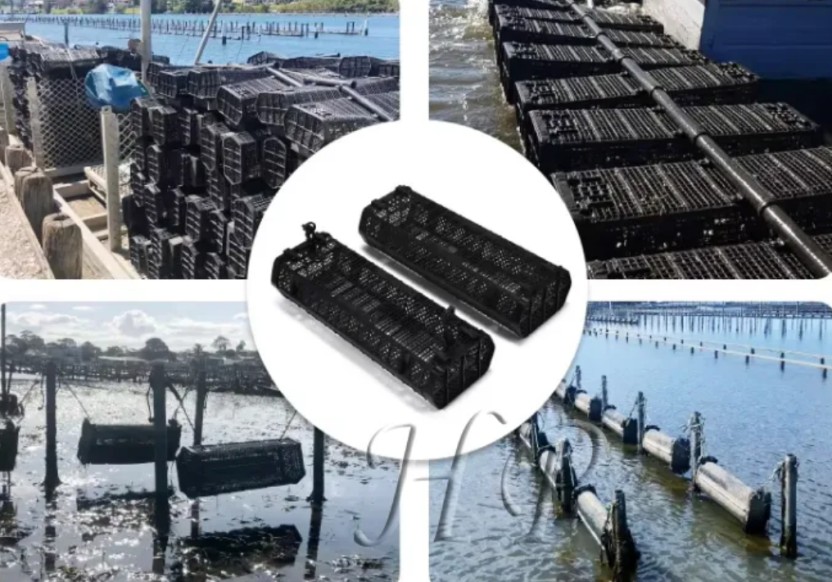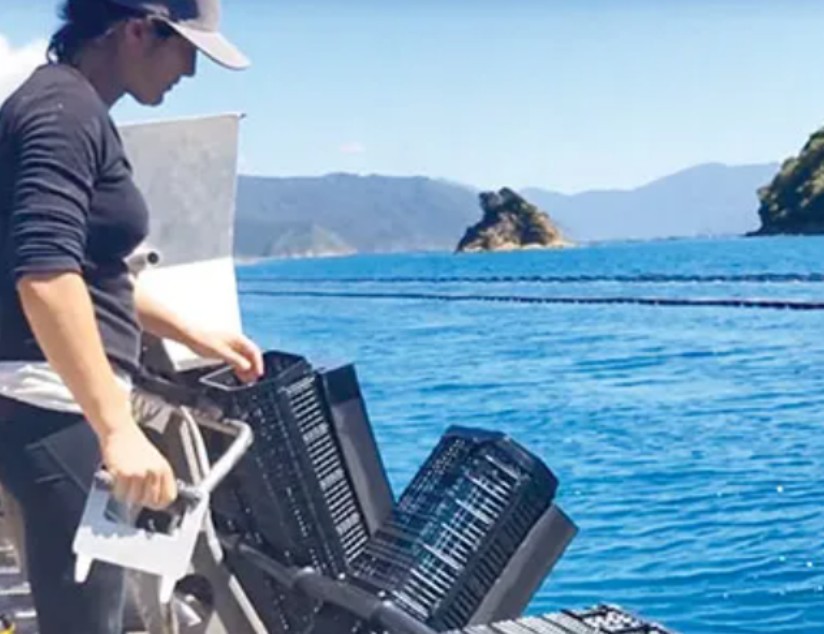Forget everything you think you know about oyster farming. Forget those sepia-toned images of old fishermen in some romantic, misty estuary hauling in heavy, mud-caked sacks. This is the old world. The new one is now being set up in those pristine tidal waters in Australia. It’s a world of precision. Of innovation. And baskets. Baskets? It almost sounds too simple, doesn’t it? How could something as humble as a basket stir up a revolution? Well, that’s just what’s happening. Along the coastlines of New South Wales, South Australia, and Tasmania, a quiet transformation is under way- and at its heart is this unassuming, profoundly impactful Australia oyster basket. It’s not just equipment, it’s a new way of farming the sea, changing the basics of what’s involved in dealing with the elements versus intelligent modular plastic crates. It’s a step from struggling against the forces of nature to making sense cooperatively with them, and everything is done through a basic modular plastic crate.
The Humble Basket’s Big Upgrade
It’s not your grandma’s big heavy wicker picnic hamper but it is a pretty serious piece of engineering usually made from tough, food-grade, UV-stabilized plastic. It’s a crate, a box, and a contained universe for an oyster to grow up in. It’s so simple, four walls, a base and maybe a lid, all pierced with a grid-like pattern of holes or slots. And in that simplicity lies a genius that was beyond what ancient methods could ever do. Think about the old way. Oysters went sticks or on trays on the sea floor or in bags. One thing’s common on all these: they kept the oyster in mostly two-dimensional, often muddy position and friendly to its predators. Constant pulling out of silt: silt that could smother oysters, starfish that could decimate a crop in no time at all. The oysters were there, helpless receivers of whatever fate the tide brought down upon them.
All of this changes completely with the Australian oyster basket. It basically lifts the oysters off the bottom and suspends them in that heavier water column, using specially built racks, or longlines introducing a third dimension to aquaculture. This single act changes everything. Now the oysters are suspended in the best part of the water with the richest plankton and maximum oxygenated water. They are not bottom dwellers, they are actually privileged middle-class citizens in this particular design of the Australia oyster basket. The design of the Australia oyster basket allows free and natural flow of water from all sides. Each oyster, whether it is in the center or on the periphery, gets its equal opportunity access to nutrient-laden broth that is seawater. This is not only to feed, this changes shape. And all this under the gentle agitation of the waves and currents which keep the baskets in motion and induce the oysters to form that much-desired smooth and deep cup with an ideal hardness that culinary experts and gourmets seek. No more weirs to break up the misshapen shells crusted with dirt. In bare essentials, the Australian oyster basket shapes oysters into well-behaved boys-always strong, always shapely, and mostly clean.
The modularity of these systems is incredible. A farmer may stack them, assemble them end-to-end, or hang them as chandeliers in the sea. It is this modular nature that provides such great flexibility. Different sizes of baskets are to be used for nursery spats, grow-out adolescents, finishing plumping before market spats, in short, for the whole life cycle of an oyster. This holistic-systems-based-on the Australian oyster basket-results in a highly efficient, perhaps the most advanced system for taking tiny spat to a premium product. It commodifies oyster farming, that is, turns it from a haphazard, almost artisanal craft into a manageable, scalable, and predictable agricultural practice. It is not merely in material, it is holistic. The basket is not a vessel, it is a base for optimized growth.
A Farmer’s New Best Friend
If you went out walking along the wharves talking to an Australian oyster farmer today the subject would come around eventually to labor. It is the number one problem in traditional aquaculture. The traditional methods were hard on one’s back. Heavy bags had to be lifted, turned, and cleaned out to avoid fouling and get even growth. That went on all day long with hardly a break in between, calling it a relentless and physically demanding cycle. With this innovation, it has been akin to handing a power tool to the industry at large. The ergonomic benefits are both immediate and great, the standardization of the baskets and the provision of handles drastically reduce the burden, making their lifting a job for the cranes serving the barges, and not as taxing a major effort for the oyster farmers. Who could previously perform a task only by lots of burly men?
This translates directly into precision: time and money and finesse, but also into the quality of oyster husbandry the oysters receive. When it’s not a Herculean task to check on your crop, you’ll check it more often and with more exactitude. A farmer draws up Australia oyster basket units in a row, unclips the lid, and performs a snap health assessment. Are the oysters growing uniformly? Is there any pest infestation? Is biofouling starting to cause a problem? This kind of access is important. Managing biofouling will give you a perfect case in point. Earlier, highly fouled bags were nightmares: heavy with excess water flow that sucked at the bottom of the bag and stunted oyster growth. It was absolute torture cleaning them up. An Australian oyster cage fouled can now just be lifted out of the water, placed on the deck of a barge and then pressure-washed or sun-dried – a much, much faster and less laborious process. The oyster is safely contained and undisturbed throughout.
By touching on management, it is possible to draw the farmer into closer contact with his stock. It no longer has to be a scenario where it is ‘out of sight, out of mind.” The farmer’s role in this sea has to be more of a shepherd than a harvester. They sort sizes, cull weak specimens, and give every single oyster in the Australian oyster basket the space and conditions it needs to be healthy. All these controls were unthinkable using bottom-culture methods. It will honor the job from brawn to expert animal husbandry. The farmer’s best friend is not a dog nowadays, it’s that trusty trooper, that durable wheeled basket that alone makes fitting sense of this new thoughtful husbandry.

Giving Oysters the Five-Star Treatment
So what’s the day-to-day life of an oyster in one of these baskets like? Imagine instead checking into a luxury high-rise that’s all you can eat, with 24/7 concierge service and always-on gentle massage. That is indeed the life for an oyster lucky enough to be grown in an Australia oyster basket. Let’s break this five-star experience down. First, the all you can eat. By hanging vertically in the water column, the oyster is directly aligned with the tidal currents, which serve as its only food source. Most convenient for the oyster to filter from the water, plankton-the microscopic algae- thrive best in such a flowing environment rich with oxygen. Where an oyster stays on the bottom and the food must settle to it, the basket-raised oyster exists in a continuous stream of fresh gourmet nutrients brought by every tide. This concentration of diet is the main reason for good meat quality and fast growth in basket farming.
And the “massage” and water movement It’s the “massage,” a gentle knocking of oysters against each other because the water’s rocking the baskets. Far from this violent shaking, there’s more the subtle rocking’ induces an oyster to build not “billowing” that can come from static environments, where the oyster shell just grows thin and flared. It’s that deep cupped shell which becomes so iconic not just a good look on a plate of ice to protect that plump juicy interior but also a mile from that silty bottom. It ensures its occupant grows in crystal clear water, far removed from that murky silty surface. The grit-free environment- it’s perfect. There’s no cause for consumers to worry and cringe at that rude crunching sound as they sip on pure oyster juice.
In containment, is the specified form of protection, and indeed, the welded rigid walls of Australia oyster basket formidably stop many natural predators of oyster. The starfish, most shellfish farmers’ curse, find it very hard to traverse through the plastic grid to come to their prey. Crabs and some types of whelks are also equally taken aback. This completely reduces the mortality rates as well as the need to use chemicals or manually control pests. This will thus help the oyster to concentrate its energy in feeding and growing rather than protection. From spat to finish within an Australia oyster basket stays comfortable curation on the way to a consistently bettered appearance, texture, and taste, aquaculture here has been refined into an art.
Dancing with the Environment
One of the strongest stories to come out of the revolution led by Australia oyster baskets is its environmental narrative. In today’s world, where more and more consumers ponder about the sustainability and ecological footprints of their meals, there lies a very strong story within oyster farming that basket farming does nothing but enhance it even more. Oysters are filter feeders. By their very nature they enhance water quality. One oyster can filter well over several liters of water per day from suspended algae, sediment, and nutrients in the general state above her waters. A whole farm: thousands of oysters working in their baskets amount to a gigantic natural water filtration system. Often these are clearer waters and healthier ecosystems in bays and estuaries hosting such farms.
The Australia oyster basket system magnifies it. Healthier, more efficient oysters mean more water filtered. The actual farming infrastructure has a negligible footprint on the seabed itself. Rather than bottom culture which can disturb sediments and create localized dead zones, basket systems suspended above the seafloor allow light to penetrate allowing seagrasses to flourish below thereby creating multi-layered marine habitat. The structures themselves become artificial reefs attracting small fish and crustaceans and other marine life which in turn boosts local biodiversity. It is a far cry from the monolithic image of industrial agriculture, this is a form of farming that actively enhances the environment it operates in.
Also, the strength and life of the new Australia oyster basket add to its green chops. Made from tough, recyclable plastics, these baskets can last for many years beating waste when put side by side with older, less strong materials. Gains in efficiency also mean fewer boat trips and less fuel use per kilo of oysters made. It is a system that knows its place inside a fine balance of nature and aims to leave it better than it found it. The farmers using these ways are not just food makers they are active hands-on stewards of their coastal waterways. The Australia oyster basket is the tool that lets them play this two-part role well showing that high-yield food making and green renewal are not at odds but can be joined in a lovely way.
The Ripple Effect on an Industry
The effect of the Australian oyster basket does not end at the shoreline, it throws ripples across the entire supply chain, from the farmer’s pocket to the consumer’s plate. For the farmer, benefits already discussed-lowered labor easier achieved higher survival rates faster growth a product that can be marketed as premium-all these culminate into one very important end result: economic viability and business resilience improved. Oyster farming is a tough game-involving nature’s vagaries, market fluctuations and biosecurity threats- but our basket system gives some stability and predictability it has never been able to elicit before. Farmer can plan their production with more confidence since a greater percentage of spat will grow to market size. This financial stability allows for better business planning, investment in further innovation and attracting a new generation to the industry.
It is this new generation that matters. The perception of oyster farming has changed. It is not seen as a gritty, purely manual trade but tech-savvy, sustainable, and exciting career path. Working the Australia oyster basket and associated technology attracts young people who want to work on the water but also want to engage with smart systems and data. They are as likely to be operating a drone monitoring their leases as they are to be hauling a basket. This modern image is vital for the long-term health of the Australian shellfish sector. On the consumer end, the effect is just as significant.Basket farmed oysters provide chefs and seafood lovers with exactly whatthey came for. A Coffin Bay oyster or a Wallis Lake oyster will grow in the same basket system and in most cases deliver what they have promised with consistent results. This creates brand trust which has seen Australian oysters competing at high levels of the international table taking on some well-established French and US players.
In these baskets, the identity of the Australian oyster is being brought up to date. Clean, bright expression due to lack of muddiness or stress on the oysters allowed per unique estuary to show its specific characteristics and flavor notes in a more pronounced, cleaner way. The Australia oyster basket-of course-is nothing more than a very revealing conduit for that local environment express itself through flavor note in the profile of an oyster. Quite like wine or cheese, it has inspired a developing appreciation culture where connoisseurs can taste the difference between a Manning River oyster and one from Pittwater. So this basket-a paradigm shift not only in farming but also in eating introduced another lovely shellfish as an intricate delicacy defined by terroir.
So the next time you shell an Australian oyster, see its deep cup and clean shell. Taste its strong flavor with no sand inside. This quiet change began not loudly but with a simple container – that modest Australia oyster box has shown itself as the spark pushing a whole field up to real new levels. It’s how easy smart setup matches man’s drive with nature’s beats making tomorrow better in work, keeping more and much tastier too. The change is here and it’s floating.


